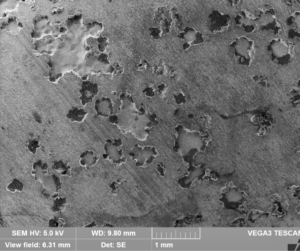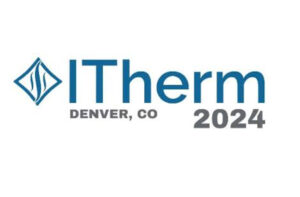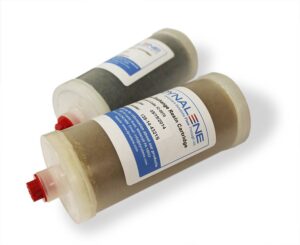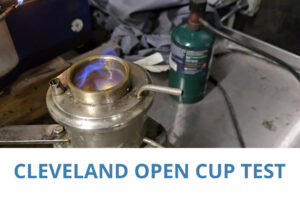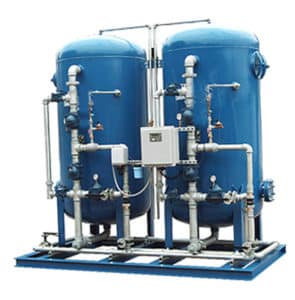Dynalene
Solar thermal hot water systems — where solar heating is used to provide hot water to process applications — are becoming common in industrial applications where hot water is at a premium. Selecting an efficient, stable fluid to transfer heat from the rooftop panel down to the hot water heat exchanger is a key step to optimizing any solar thermal hot water system.
Solar rooftop panels can reach temperature exceeding 300°F (149°C). This temperature normally does not pose an issue as long as the heat transfer fluid circulates through the panel and removes heat. Issues can occur, however, when the fluid stops circulating due to a power outage or pump failure. If stagnant fluid in the panel reaches high temperatures, a number of scenarios are possible, depending on system design.
Common designs to deal stagnant fluid are drain back, boil back and allowing fluid to fill the panel. In the drain back system, when the pumps turn off, the fluid is drained from the panel and stored in a reservoir. This removes all but a residual amount of heat transfer fluid. In boil-back or boil-off systems, the heat transfer fluid is allowed to boil and then condensed and stored in a reservoir. Alternately, it is released through a valve to atmosphere. In the third approach, when the fluid is not being pumped, the system allows the fluid to stagnate in the panel under pressure. During these situations, glycols can cause problems in the system if allowed to stagnate.
Typically, any time a system has a glycol bulk temperature in the range of 250°F (121°C), fluid degradation increases. In all three scenarios, if a glycol fluid is used, the residual glycol remaining in the panels becomes acidic and can cause corrosion issues. While stagnation situations do not happen often or for extended periods of time, when they occur, glycol degradation potentially can do enough damage that early replacement of the fluid and parts of the panel might be necessary.
Choosing a glycol-and-inhibitor package can minimize the damage and prolong the life of the system even under normal working conditions. The following criteria could be used to choose the right type of glycol for a solar thermal application:
- High thermally stability at temperatures up to 350°F (177°C).
- Nontoxic.
- Good corrosion protection.
- High reserve alkalinity or good pH buffering.
The typical inhibitor package, which will protect most metals in the system including copper and steel at normal temperatures, must be adjusted for the higher temperatures that can occur in the solar thermal hot water systems. Normally, in a glycol system, the inhibitor will add to the reserve alkalinity of the fluid. Reserve alkalinity is a chemical property that helps keep the pH stable and slows the increase in acids as the glycol degrades. For a typical inhibited-propylene glycol, the reserve alkalinity normally is greater than 10.0. This works well for systems with working temperatures below 250°F (121°C) because the glycol degrades at a very slow rate. When solar thermal hot water heaters stagnate, temperatures can exceed 300°F (149°C). The reserve alkalinity must be adjusted to between 18 and 25, depending on the glycol. This should ensure that as acids form in the fluid, they will be neutralized and minimize the potential corrosion.r> Three common glycols are used for heat transfer and freeze protection. The first, monoethylene glycol (1,2 ethanediol), or ethylene glycol, is the most common antifreeze in the glycol family. It is used mainly in the automotive and HVAC industries. Ethylene glycol has good thermal and physical properties when compared to other common glycols, but it is considered toxic and not normally used for domestic hot water systems for that reason. It also degrades much faster than other glycols at the higher temperature required with the solar thermal systems.
A second option is monopropylene glycol (1,2 propanediol), more commonly known as propylene glycol. This has become the antifreeze of choice for some process heat transfer applications and most commercial HVAC systems. It is safe and nontoxic, and it commonly is used in domestic hot water systems due to its safety. It degrades more slowly than ethylene glycol but exhibits lower performance due to high viscosity and lower thermal conductivity.
A third option is trimethylene glycol (1,3 propanediol) a bio-derived, thermally stable glycol. Unlike typical 1,3 propanediol, which is derived from oil or natural gas, the bio-derived “green” glycol is produced from corn sugar. Manufacturing the green glycol yields 30 percent less greenhouse gases than the process that produces propylene glycol. The renewable, green alternative to ethylene or propylene glycol has a slower thermal degradation rate than both ethylene glycol and propylene glycol, and outperforms propylene glycol’s viscosity at lower temperatures.
For solar thermal applications, mixtures based on propylene glycol or the green glycol are recommended. Both fluids can be inhibited and adjusted for a higher reserve alkalinity to slow degradation. They offer safe, nontoxic solutions. The green glycol provides better thermal and physical properties while being renewable and more environmentally friendly than propylene glycol, but it has a higher cost. Propylene glycol is a well-known chemistry and has a proven record with process and HVAC systems. Selecting a heat transfer fluid for solar thermal heating does not have to be hard if a few aspects are considered up front.


